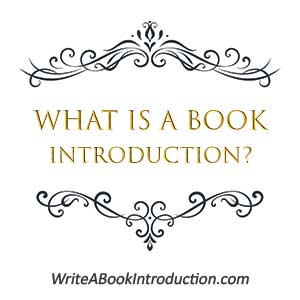What Is an Introduction in a Book?
 What is an introduction to a book? This article breaks down the purpose, elements, and significance of a book introduction. It also explores when you should write a book introduction, and when you can skip it. This article is part of a series about how to write a book introduction, written by a former literary agent who’s helped 400+ authors get literary agents and/or traditional publishers.
What is an introduction to a book? This article breaks down the purpose, elements, and significance of a book introduction. It also explores when you should write a book introduction, and when you can skip it. This article is part of a series about how to write a book introduction, written by a former literary agent who’s helped 400+ authors get literary agents and/or traditional publishers.
What is a Book Introduction?
A book introduction is a section at the beginning of a book that engages readers, explains its purpose, and outlines its content. It typically includes a hook, highlights the book’s relevance, establishes the author’s credibility, and provides a roadmap, preparing readers for the journey ahead.
The Purpose of a Book Introduction
The introduction serves multiple functions, all aimed at engaging the reader and setting the stage for the main content.
Engaging the Reader
- A strong introduction captures the reader’s attention right away, often with a hook like a compelling question, a surprising fact, or an intriguing anecdote.
- It builds curiosity and motivates the reader to delve deeper into the book.
Explaining the Book’s Relevance
- The introduction connects the book’s subject matter to the reader’s needs or interests.
- It answers the reader’s unspoken question: Why should I care about this book?
Establishing the Author’s Credibility
- The author uses the introduction to demonstrate their authority or expertise on the subject.
- Personal anecdotes, professional experiences, or research credentials can be included to build trust with the reader.
Providing a Roadmap
- The introduction outlines the structure and key themes of the book.
- It helps the reader understand what to expect and how the chapters will unfold.
Elements of a Book Introduction
While every book is unique, most introductions include a few key elements:
1. The Hook
- A memorable opening grabs attention and sets the tone. Examples of hooks include:
- A startling statistic: “Did you know that 80% of people abandon their New Year’s resolutions by February?”
- A provocative question: “What if everything you thought about productivity was wrong?”
- A personal story: “In 2015, I found myself at rock bottom, and that’s where this journey begins.”
2. The Problem or Question
- Clearly define the problem your book addresses or the central question it aims to answer.
- This helps the reader understand the book’s purpose and relevance to their own life or interests.
3. The Promise or Value
- Highlight the benefits the reader will gain from the book. For example:
- “This book will teach you how to overcome procrastination and achieve your goals effortlessly.”
4. The Author’s Perspective
- Share why you wrote the book and what unique insights or solutions you bring to the topic.
- This could include your personal connection to the subject or your professional expertise.
5. The Roadmap
- Briefly summarize the book’s structure, including the main topics or themes covered in each section.
- This provides clarity and sets expectations for the reader.
The Importance of Having a Book Introduction
When writing a book, one of the first questions authors often face is whether or not to include an introduction. While introductions can set the stage, engage readers, and clarify the book’s purpose, they aren’t always necessary. The decision depends on the book’s genre, audience, and intent. This article explores the purpose of a book introduction, its benefits, and when you might consider skipping it.
Do You Need a Book Introduction?
Including an introduction depends on the type of book you’re writing and your goals for engaging the reader. Here’s when an introduction is most beneficial:
1. Nonfiction Books
- Why You Need It:
- Nonfiction readers expect clarity and structure. An introduction helps them understand the book’s relevance and content.
- Examples:
- Self-help, business, or academic books often use introductions to define problems and outline solutions.
- Purpose:
- Builds trust by establishing the author’s credibility.
- Frames the book’s key ideas and value.
2. Memoirs and Autobiographies
- Why You Need It:
- Introductions in memoirs set the tone and context for the personal journey that follows.
- Examples:
- A memoir about overcoming adversity might use the introduction to briefly summarize the challenges and lessons learned.
- Purpose:
- Draws readers in with emotional resonance.
- Provides a thematic preview of the book.
3. Niche or Specialized Topics
- Why You Need It:
- Books on technical, historical, or specialized topics benefit from introductions to orient readers and explain the significance of the subject.
- Examples:
- A book on artificial intelligence might use the introduction to highlight its growing impact on society.
- Purpose:
- Clarifies the book’s scope and audience.
- Demonstrates why the topic matters.
When You Can Skip an Introduction
While introductions are often helpful, some books may not need one. Here are scenarios where you might skip the introduction:
Fiction Books
- Why You Might Skip It:
- Fiction readers typically prefer to dive straight into the story rather than reading background or explanations.
- Exceptions:
- Historical fiction or speculative fiction may include a brief introduction to provide necessary context for the story.
- Alternative:
- Use a prologue if background information is essential to setting the stage.
Short Books or Straightforward Topics
- Why You Might Skip It:
- In books with simple and direct content, an introduction can feel redundant.
- Examples:
- A short guide or workbook where the title and first chapter make the purpose clear.
- Alternative:
- Use the first chapter to address key points immediately.
Engaging Opening Chapters
- Why You Might Skip It:
- If your opening chapter naturally draws readers in and provides clarity, an introduction might be unnecessary.
- Examples:
- A gripping self-help book that begins with a powerful anecdote or example.
Conclusion – What Is a Book Introduction?
A book introduction is more than just an opening—it’s a gateway that invites readers into the world of your book. Whether you’re writing nonfiction, a memoir, or even a piece of fiction that requires context, a well-crafted introduction can captivate readers, clarify your book’s purpose, and set the tone for an unforgettable reading experience. By focusing on your audience, delivering a clear message, and hooking readers from the start, your introduction can become one of the most impactful parts of your book.
Now that you’ve read “What Is a Book Introduction?” click here for the next article about how to write a book introduction, “Book Preface vs Introduction.”


 This guide about
This guide about 